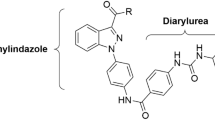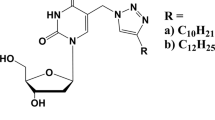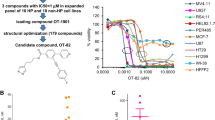Abstract
THE possibility of preferential inhibition of tumour growth with antimetabolites of hexose monophosphate pathway intermediates was suggested by Sahasrabudhe1. In pursuance of this suggestion it was shown that thiophene-2 : 5-dicarboxylic acid, administered as its sodium salt, significantly inhibited the growth of transplantable fibrosarcoma in mice, and also increased the survival of Yoshida (ascites) sarcoma-bearing rats2. It was further shown that since this sodium salt is soluble in water, it was probably excreted rapidly. When the total daily dose of thiophene-2 : 5-dicarboxylic acid was increased and the injection schedule evenly spaced during the day to maintain adequate drug concentration, it was found that the inhibitory effects were significantly enhanced. It was therefore felt that if the free carboxy groups of the acid were esterified to reduce its solubility in water, the drug concentration might remain steady in the system for longer periods. In addition to this, if two hydroxy groups are introduced at the third and fourth positions of the thiophene-2 : 5-dicarboxylic acid molecule, it was thought that the resemblance between the sugar intermediates of the hexose monophosphate pathway and the antimetabolite would be increased, and the effectivity against cancer might also increase. With these objectives in view 2 : 5-dicarbethoxy-3 : 4-dihydroxy-thiophene (hereafter referred as ‘Dicetol’) was synthesized3. Dicetol is insoluble in water and therefore it was converted into a water-soluble disodio-dicetol by treatment with ethanolic sodium ethoxide, to facilitate its administration in aqueous medium. Disodio-dicetol readily hydrolyses in the presence of carbon dioxide. It was therefore felt that the water-soluble compound, used for practical reasons, would be transformed in the body into an insoluble dicetol, which would probably be retained in the system for longer periods. The present communication reports the results of preliminary screening trials with disodio-dicetol.
This is a preview of subscription content, access via your institution
Access options
Subscribe to this journal
Receive 51 print issues and online access
$199.00 per year
only $3.90 per issue
Buy this article
- Purchase on Springer Link
- Instant access to full article PDF
Prices may be subject to local taxes which are calculated during checkout
Similar content being viewed by others
References
Sahasrabudhe, M. B., Nature, 182, 163 (1958).
Sahasrabudhe, M. B., Nerurkar, M. K., Narurkar, M. V., Tilak, B. D., and Bhavsar, M. D. (in the press).
Overberger, C. G., and Joginder, Lal, J. Amer. Chem. Soc., 78 2956
Waravdekar, S. S., and Ranadive, K. J., J. Nat. Cancer Inst., 18, 555 (1957).
Author information
Authors and Affiliations
Rights and permissions
About this article
Cite this article
SAHASRABUDHE, M., NARURKAR, M., KOTNIS, L. et al. Inhibition of Tumour Growth with 2 : 5-Dicarbethoxy-3 : 4-Dihydroxy-Thiophene. Nature 184, 201–202 (1959). https://doi.org/10.1038/184201a0
Issue Date:
DOI: https://doi.org/10.1038/184201a0
This article is cited by
-
Phenanthroimidazoles, IV
Monatshefte für Chemie - Chemical Monthly (1982)
-
Anticancer Properties of Thio-diglycollic Acid
Nature (1961)
Comments
By submitting a comment you agree to abide by our Terms and Community Guidelines. If you find something abusive or that does not comply with our terms or guidelines please flag it as inappropriate.



